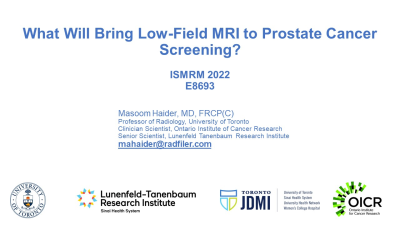Sunrise Course
Hot Topics in Body MRI: MRI of Gender Imaging
Joint Annual Meeting ISMRM-ESMRMB & ISMRT 31st Annual Meeting • 07-12 May 2022 • London, UK

| 08:00 | Evaluating Metastatic Ovarian Malignancy: Does MRI Provide Gains over CT?
Anju Sahdev
A woman’s lifetime risk of developing invasive ovarian cancer is 1 in 79 and most present with metastatic disease and continue to have a poor outcome. Metastatic disease, in present standard practice, is detected and surgically mapped by CT of the chest, abdomen and pelvis. On a lesion-by-lesion basis MRI with DWI and with post gadolinium enhancement detects more lesions than CT. However, overall MRI has a limited role for staging at primary presentation and overall offers only limited superiority over CT. For primary and recurrent disease, MRI’s role in pelvic disease detection and surgical planning is superior to CT.
|
||
| 08:30 |  |
What Will Bring Low-Field MRI to Prostate Cancer Screening?
Masoom Haider
Low field MRI has the potential to aid in wider global utilization of MRI for prostate cancer diagnosis through cost reduction and easier installation and lower service costs. If optimized it also can help improve image quality for example, through reduced susceptibility. Patients with pacemakers may be able to undergo DWI more easily. MRI guided biopsy and intervention may also benefit from improved siting and less demands on hardware Further work in optimal hardware engineering and image pipeline optimization is needed.
|
The International Society for Magnetic Resonance in Medicine is accredited by the Accreditation Council for Continuing Medical Education to provide continuing medical education for physicians.